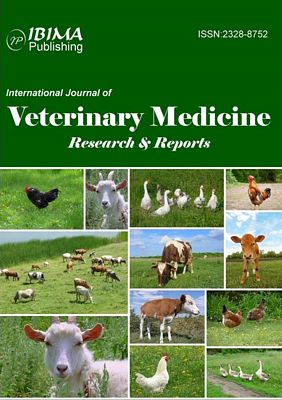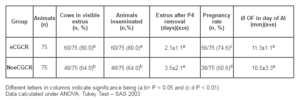Administration of eCG in acyclic dairy cows previously treated with P4 has been recommended (Pinheiro et al., 2009, Bryan et al., 2013; Marquezini et al., 2013) since FSH and LH can induce ovarian follicle development and ovulation (; Yavas and Walton, 2000). The present study evaluated the effects of eCG treatment along with 48-h calf removal after an 8-day P4 protocol in suckling Nelore cows. Nelore cows in anestrous postpartum were submitted to AI after estrus observation, resulting in a pregnancy rate of 74.6% and 50.6% in the eCGCR and NoeCGCR groups, respectively (P < 0.01). Our results were better than those obtained by Belloso et al., (2002) who performed a similar experiment in Bos indicus primiparous cows under anestrous conditions. They submitted the cows to P4 protocols with fixed-time artificial insemination (TAI) and TW (temporary weaning) for 96 h (G1) and with eCG (G2) achieving conception rates of 61.5% and 67.7%, respectively. Similarly, in another study, Marquesini et al., (2013) used eCG after 7 days of intravaginal P4 and observed increased dominant follicle (DF) diameter at the TAI, but there was no influence on the pregnancy rate of Bos taurus beef cattle. Sá Filho et al., (2010 b) observed improvement in pregnancy rates when eCG was used along with PGF administration using a controlled internal drug-releasing device and CR. Our results (PR) can be assigned the cows were inseminated after the visible estrus. Protocols combining progestin, eCG, and temporary removal of calves are important tools that can be used to synchronize estrus (; Meneghetti et al., 2001; 2009; Sá Filho et al., 2010b). Others studies using eCG, with or without TW, did not yield consistent results. Temporary calf removal, with or without eCG administration, did not significantly alter the pregnancy rates in TAI by suckling Nelore cows (Pinheiro et al., 2009) or in Bos indicus heifers (Butler et al., 2011), emphasizing that these authors employed fixed-time artificial insemination (FTAI). Vasconcelos et al., (2009) showed that the temporary removal of calves increased the estrus rate and improved reproductive performance in Angus × Nelore crossbred anestrus cows; estrus induction was observed even in cows with a DF having a size of less than 7 mm. This corroborates the results of the present study, indicating the reason for the difference between the eCGCR group and NoeCGCR (p < 0.05) on the visible manifestation of estrus. Our hypothesis was that the association of eCG and CR could exert beneficial effects, because eCG would induce the development of ovarian follicles and ovulation in lactating dairy cows previously treated with progesterone (Yavas and Walton, 2000) and the CR would increase the frequency of LH pulses up to the final follicle maturation and ovulation (; Kawashima et al., 2008).
Regarding the size of ovulatory follicles (OFs) on the AI day, Meneghetti et al., (2001) suggested that the temporary removal (48 h) of calves resulted in increased size of the DF and ovulation rate in anestrus Nelore cows compared to the cows that remained with calves. In the present study, the diameter of OFs was larger, but not statistically significant, in the treated group than in the control. Our data are in agreement to those obtained in Nelore cows by Borges et al., (2003) who reported that the diameter of OFs was 11.0 mm, which is very close to the diameter found in our study (11.3mm; table 1) and different from that reported by Ferraz et al., (2009) (9.1 mm). This difference could be assigned to the difference in body condition score.
In conclusion, the use of eCG + CR after a long-term P4 protocol yielded better results and improved pregnancy rates and estrus induction.
References
Baruselli, O.S., Reis, E.L. & Marques, M.O.(2004). The use of hormonal treatments to improve reproductive performance of anestrous beef cattle in tropical climates. Animal Reproduction Science, 82-83: 479-486.
Publisher – Google Scholar
Belloso, E.S., Portillo Martinez, G., De Ondiz, A., Rojas, N., Castillo, G.S. & Ramirez Iglesia, L.( 2002). Improvement of reproductive performance in crossbred zebu anestrous primiparous cows by treatment with norgestomet implants or 96 h calf removal. Theriogenology, 57: 1503-1510.
Publisher – Google Scholar
Bellows, R.A. & Short, R.E.(1994). Reproductive losses in beef industry. In: Fields, J.M. & Sand, R.S. Factors affecting calf crop. Boca Raton: CRC Press :109-133.
Bó,. G.A., Cutaia, L. & Reis, L.( 2004). El uso de tratamientos hormonales para mejorar el desempeño reproductivo en ganado de carne en anestro en climas tropicales. In: Simposio Internacional de Reproducción Bovina, 1., Barquisimeto. Anais… Barquisimeto, 2004 :125-137.
Borges,A.M., Torres, C.A.A., Ruas, J.R.M., Rocha Junior, V.R., Carvalho, G.R. & Fonseca, J.F.( 2003). “Características da Dinâmica Folicular e Regressão Luteal de Vacas das Raças Gir e Nelore após Tratamento com Cloprostenol Sódico”. Revista Brasileira de Zootecnia, 32(1):85-92.
Publisher – Google Scholar
Borges,A.M.; Torres, C.A.A,; Rocha Júnior, V.R; Ruas, J.R.M.Ruas.; Carvalho, G.R.; Marcatti Neto, A. and Carvalho, B.C. Follicular development in Gir breed cows (Bos indicus) treated with buserelin acetate or human chorionic gonadotrophin during the postpartum period. Revista Brasileira de Zootecnia, 33(6): 21-26, 2004.
Bryan, M.A., Bó, G., Mapletoft, R.J. and Emslie, F.R.( 2013). “The use of equine chorionic gonadotropin in the treatment of anestrous dairy cows in gonadotropin-releasing hormone/progesterone protocols of 6 or 7 days”, Journal of Dairy Science, 96(1):122-131.
Publisher
Butler, S.A.A., Atkinson, P.C., Boe-Hansen, G.B., Burns, B.M., Dawson, K. & Bo, G.A.( 2011). “Pregnancy rates after fixed-time artificial insemination of Brahman heifers treated to synchronize ovulation with low-dose intravaginal progesterone releasing devices with or without eCG”. Theriogenology, 76: 1416-1423.
Publisher – Google Scholar
Cubas, A.C., Mancio, A.B. & Lesskiu, C.(1985). “Efeito da amamentação controlada sobre a eficiência reprodutiva de vacas de corte no sul do Paraná”. Revista Brasileira de Zootecnia,14: 247-255.
Ereno, R.L., Barreiros, T.R.R., Seneda, M.M., Baruselli, P.S., Pegorer, M.F. & Barros, C.M., (2007). “Taxa de prenhez de vacas Nelore lactantes tratadas com progesterona associada à remoção temporária de bezerros ou aplicação de gonadotrofina coriônica equina”. Revista Brasileira de Zootecnia, 36 (5): 1288-1294.
Publisher – Google Scholar
Fantini Filho, J.C., Kozicki, L.E. & Souza, F.P. (2004). “Induction of accessory Corpus luteum by human chorionic gonadotropin (hCG) and the relationship with progesterone concentrations in cattle”. Archives of Veterinary Science, 9 (1): 115-120.
Ferraz, H.T., Oliveira Filho, B.D., Gambarini, M.L., Viu, M.A.O., Lopes, D.T. & Rezende, L.C. ( 2009). “Desenvolvimento folicular e ovulação de fêmeas nelore (Bos taurus indicus) sincronizadas”. Arquivos de Zootecnia, 58 (Supl. 1): 585-588.
Hopkins, S.M.(1986). “Bovine anestrus diagnosis, treatment and prevention of reproductive diseases in small and large animals”, W.B. Saunders, Toronto :247-250.
Kawashima, C., Kida, K., Matsuhashi, M., Matsui, M., Shimizu, T. & Matsunaga, N. ( 2008). “Effect of suckling on the reproductive performance and metabolic status of obese Japanese Black cattle during the early postpartum period”.Journal Reproduction and Development, 54:46-51.
Publisher
Marquesini, G.H., Mercadante, V.R., Olson, K.C., Jaeger, J.R., Perry, G.A., Stevenson, J.S. & Lamb,G.C. (2013).“Effects of equine chorionic gonadotropin on follicle development and pregnancy rates in suckled beef cows with or without calf removal”. Journal of Animal Science, 91(3):1216-1224.
Publisher – Google Scholar
McDonald, S. Postpartum anestrum in the pasture grazed New Zealand dairy cows. Thesis. Department of Veterinary Clinical Sciences, Massey University, 247p. 1994.
Meneghetti, M., Vilela, E.R. & Vasconcelos, J.L.M. (2001). ”Efeito da remoção dos bezerros nos folículos dominante e na taxa de ovulação ao primeiro GnRH em protocolos de sincronização em vacas Nelore em anestro”. Revista Brasileira de Reprodução Animal, 25 (3): 286-288.
Moreira, R.J.C. (2002). “Uso do protocolo Crestar® em tratamentos utilizando benzoato de estradiol, PGF2alfa, PMSG e GnRH para controle do ciclo estral e ovulação em vacas de corte”.[Dissertação de Mestrado]. 62p. Piracicaba, São Paulo — Brasil: ESALC.
Pencai, F.W., Kozicki, L.E., Costa, C.E.M.P., Silva, N.L., Molleta, J.L. & Motta, J.B.O.(2011). “Indução ao estro pós puerperal em bovinos mestiços de corte mediante emprego de diferentes protocolos de amamentação”. Veterinaria e Zootecnia.18 (1): 53-62.
Pinheiro, V.G., Souza, A.F., Pegorer, M.F., Satrapa, R.A., Ereno, R.L. & Trinca, L.A. (2009). “Effects of temporary calf removal and eCG on pregnancy rates to timed-insemination in progesterone-treated postpartum Nellore cows”. Theriogenology. 72: 179-189.
Rajamahendran,R., Divakar,J., Ambrose,J., Small,A.(2001). Synchronization of estrus and Ovulation in cattle. Archiv Tierarztz., 44 (Special Issue): 58-67.
Sá Filho, M.F., Ayres, H., Ferreira, R.M., Marques, M.O., Reis, E.L., Silva, R.C., Rodrigues, C.A., Madureira, E.H., Bó, G.A.& Baruselli P.S. (2010). “Equine chorionic gonadotropin and gonadotropin-releasing hormone enhance fertility in a norgestomet-based, timed artificial insemination protocol in suckled Nelore (Bos indicus) cows”. Theriogenology, 73(5):651-658.
Publicher – Google Scholar
Sá Filho, O.G., Dias, C.C., Lamb, G.C. & Vasconcelos, J.L.M.( 2010). “Progesterone-based estrous synchronization protocols in non-suckled and suckled primiparous Bos indicus beef cows”. Animal Reproduction Science. 119(1-2):9-16.
Publisher – Google Scholar
Shively, T.E. & Williams, G.L. (1989). “Patterns of tonic luteinizing hormone release and ovulation frequency in suckled anestrous beef cows following varying intervals of temporary weaning”. Domestic Animal and Endocrinology, 6: 379-387.
Publisher – Google Scholar
SAS. Statistical Analysis System. SAS/STAT Users guide. Cary, NC, USA: SAS Inst., Inc., 1999.
Vasconcelos, J.L.M., Sá Filho, O.G., Perez, G.C. & Silva, A.T.N. (2009). “Intravaginal progestrerone device and/or temporary weaning on reproductive performance of anestrous crossbreed Angus x Nelore cows”. Animal Reproduction Science,111: 302-311.
Publisher – Google Scholar
Willians, G.L. & Griffith, M.K.(1995). “Sensory and behavioural control of gonadotrophin secretion during suckling-mediated anovulation in cows”. Journal of Reproduction and Fertility.(supl) 49: 463-475.
Yavas, Y. & Walton, J.S. (2000). “Induction of ovulation in postpartum sucked beef cows: a review”. Theriogenology, 54 : 01-23.
Zimmer, A.H. & Euclides Filho, K. (1997). “As pastagens e a pecuária de corte brasileira. In: Simpósio Internacional sobre Produção Animal em Pastejo”, 1997, Anais… Viçosa, MG: Universidade Federal de Viçosa, :349-379.




